This is the list of Nectus System Variables that can be used in AWS Monitoring Email or SMS Alerts.
Manual Network Discovery Operation
Starting from Version 1.2.49 Nectus implements new and enhanced user interface for manually starting and stopping of Network Discovery.
To manually start network discovery, go to Tools → Manual Discovery Start
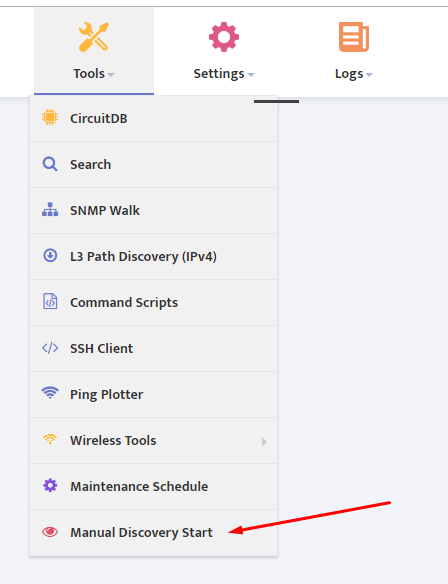
Where you will be presented with two options: Full Discovery and Partial Discovery
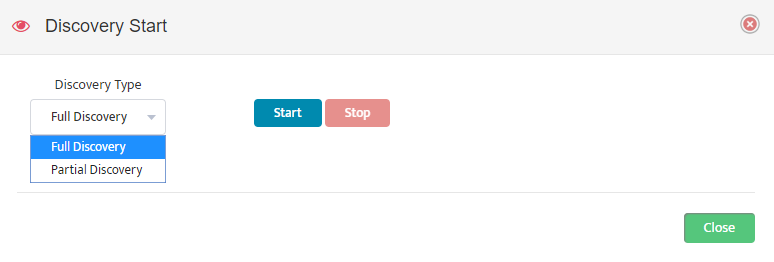
Full Discovery will perform ICMP/SNMP Scan on all subnets configured in global Network Discovery settings.
Partial Discovery gives an option to limit discovery to very specific subnets or single IP address.
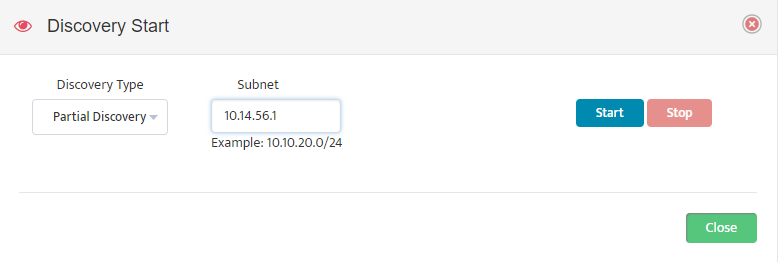
In addition to Manual Start/Stop Option, Version 1.2.49 shows Discovery log with new column Type that differentiates Manual or Scheduled Discovery execution types.
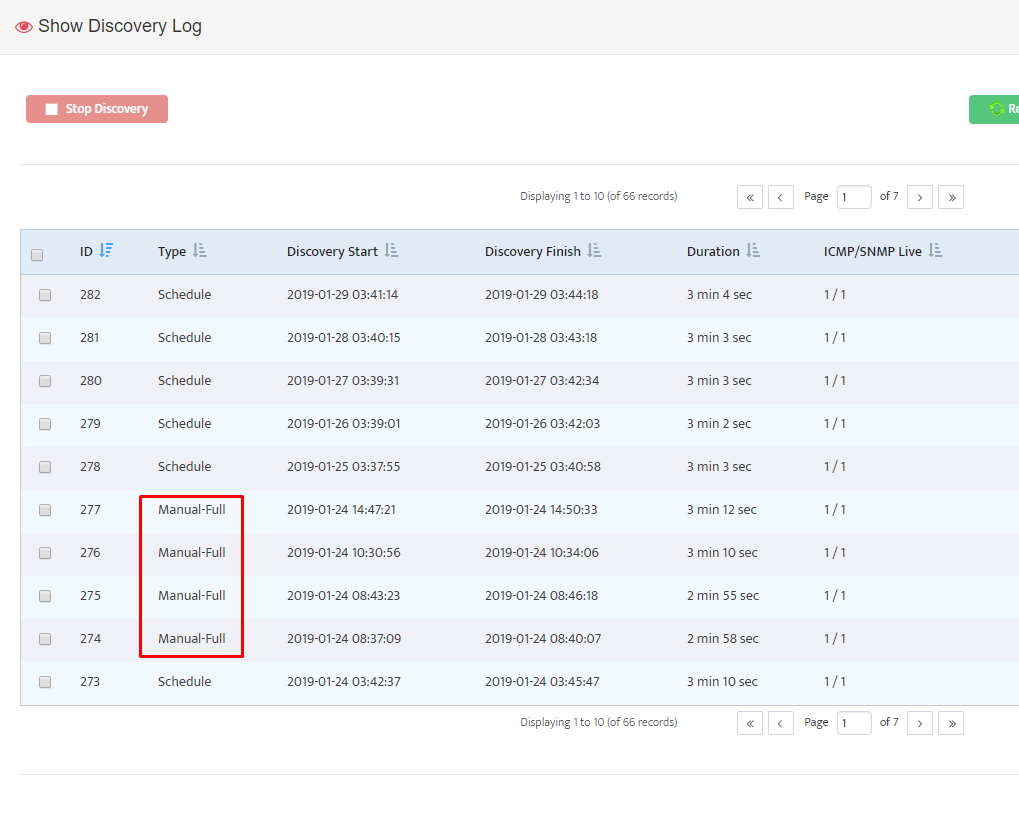
Monitoring Windows Server Storage Utilization with Nectus
In this chapter, you’ll learn how to use WMI to monitor Windows Server Storage Utilization. Nectus lets you create Profiles that specify which Servers to monitor with WMI and to send Alerts related to them. It also provides graphs of Server Utilization over time.
The specific topics we will cover in this chapter are:
- What is WMI?
- Why Monitor Windows Server Storage Utilization?
- Creating a WMI Server Group
- Adding a Server to the WMI Server Group
- Creating and Configuring a WMI Monitoring Profile
- Assigning a Profile to the WMI Server Group
- Viewing a Storage Utilization Graph
1. What is WMI?
WMI (Windows Management Instrumentation) is a set of specifications and interfaces that provides information about the status of local and remote computers running Microsoft Windows. In this chapter we look at how Nectus uses WMI to monitor the Storage Utilization on Windows Servers and send Alerts based on that information.
Note: WMI is the Microsoft implementation of the Web-Based Enterprise Management (WBEM) standard and the Common Information Model (CIM) standard from the Distributed Management Task Force (DMTF).
2. Why Monitor Windows Server Storage Utilization?
Monitoring when Storage Utilization goes outside of the expected Thresholds alerts you to various problems. For example, exceeding the Maximum Threshold could indicate that a Server needs a larger disk, or that some other application is using space on the disk. Utilization below the Minimum Threshold could indicate that data is not being received by the Server, or a problem is keeping the data from being written to the disk.
3. Creating a WMI Server Group
To create a WMI Server Group open the WMI Servers Panel on the Nectus Home Screen. Right-click the WMI Servers list. In the menu that appears, click Add New Group.

This opens the “Add New WMI Server Group” dialog box.
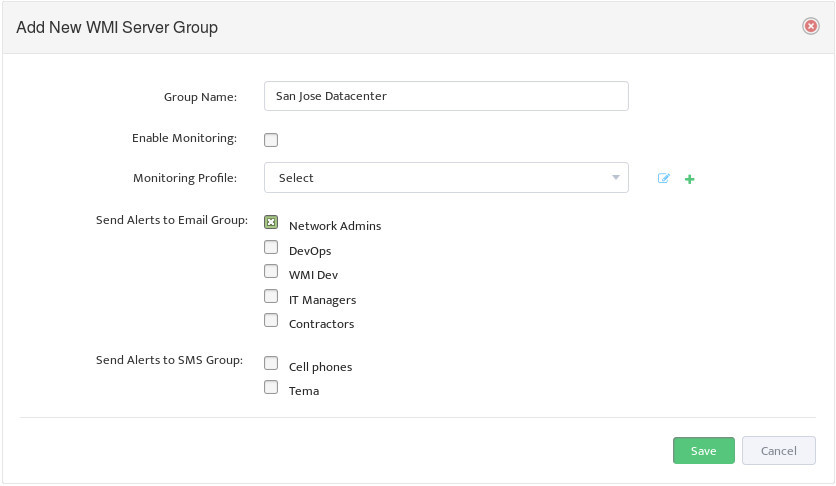
Enter a Group Name, then select the Email Groups and SMS Groups that will receive Alerts.
4. Adding a Server to the WMI Server Group
To add a Windows Server to the WMI Server Group right-click the Group and select Add New WMI Server.
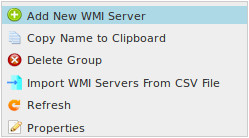
This opens the “Add WMI Server” dialog box.

Enter the IP address of the Server you want to add to the Group. Alternately, you can move a Server from its current Group to this Group by right-clicking the Server and using the Move WMI Server to option.
5. Creating and Configuring a WMI Monitoring Profile
To create a WMI Monitoring Profile go to the Nectus Home Screen and select Monitoring -> WMI Monitoring Settings.
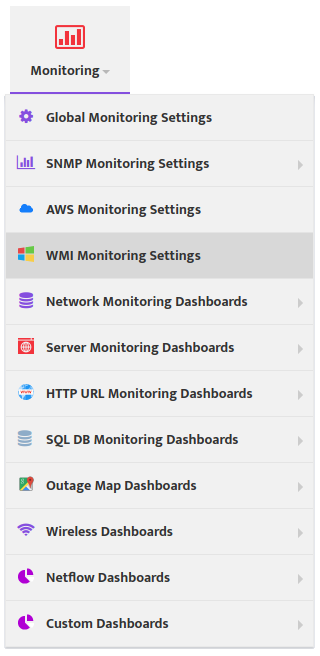
This opens the “WMI Monitoring Settings” dialog box.
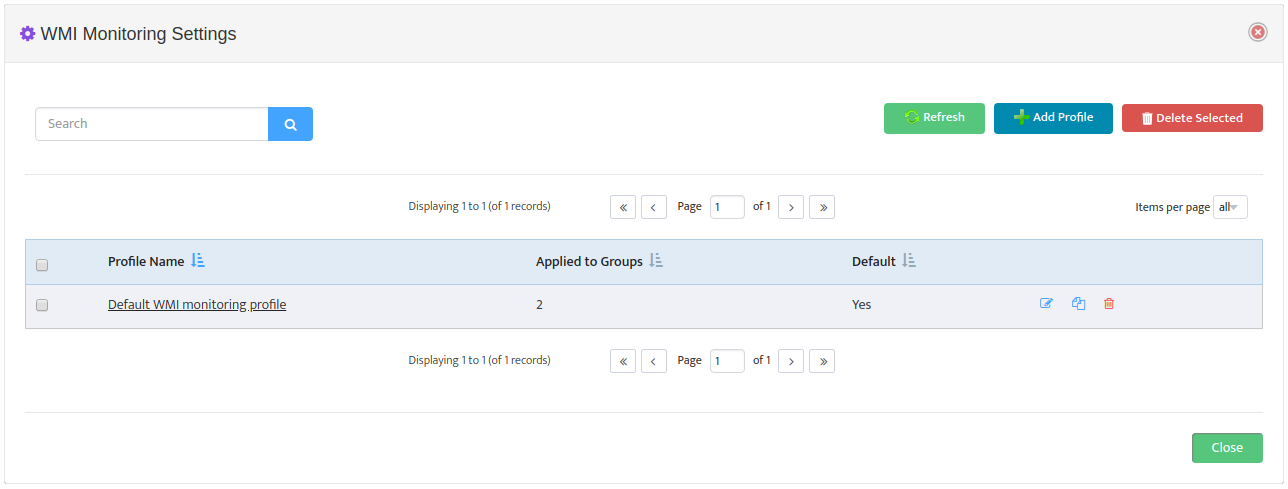
Click Add Profile -> Disk.

Enter the Monitoring Profile Name and check the Enabled box next to the Disk Used Space metric. Check the types of Alerts you want the Profile to send.
Check the Default Profile box if you want to make this the new default WMI Monitoring Profile.
5.1 Editing Disk Used Space Options
Select the Disk Used Space Options icon to open the “WMI Options – Disk Used Space, %” dialog box.
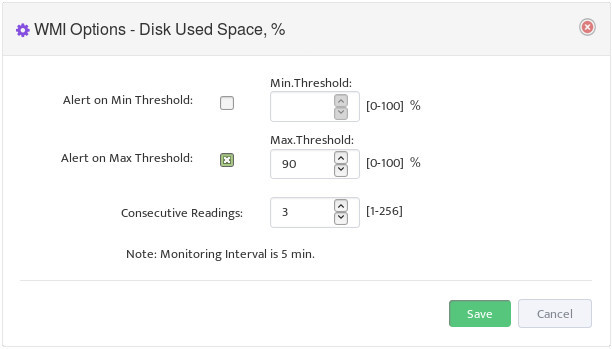
Set the Alert Thresholds you want to monitor, as well as the number of Consecutive Readings that a Threshold must be exceeded before triggering an alert. Nectus checks the thresholds every 5 minutes, so setting Consecutive Readings to 3 means a value would need to exceed the assigned Threshold for 15 minutes before triggering an alert.
5.2 Editing Disk Used Space Alert Templates
To edit the format of Alerts return to the Disk tab of the “Add WMI Monitoring Profile” dialog box. Click the Disk Used Space Alert Templates icon to open the “Edit Alert Handler” dialog box.
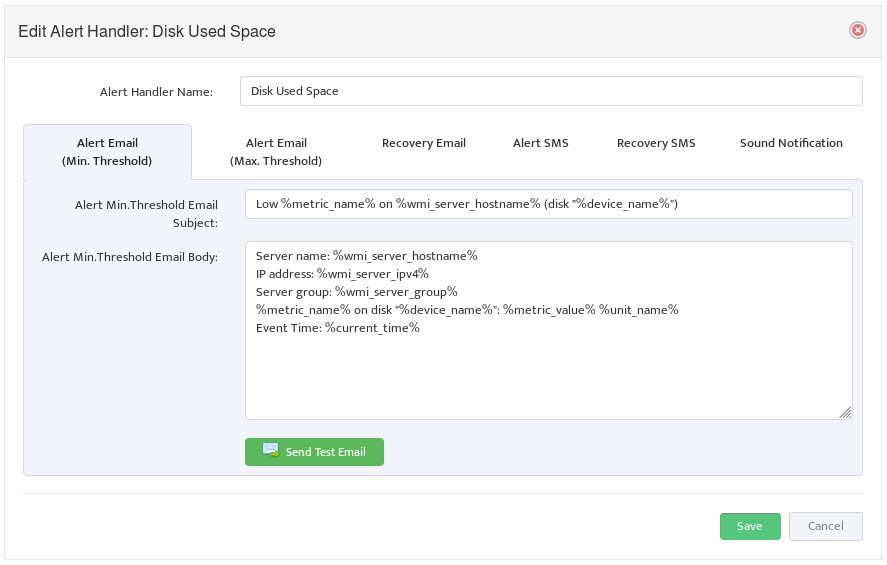
6. Assigning a Profile to the WMI Server Group
In the WMI Servers Panel on the Nectus Home screen, open the WMI Servers list. Right-click the WMI Server Group and select Properties.
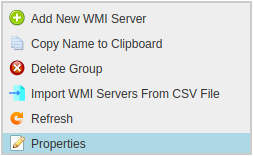
This opens the “Edit WMI Server Group” dialog box.
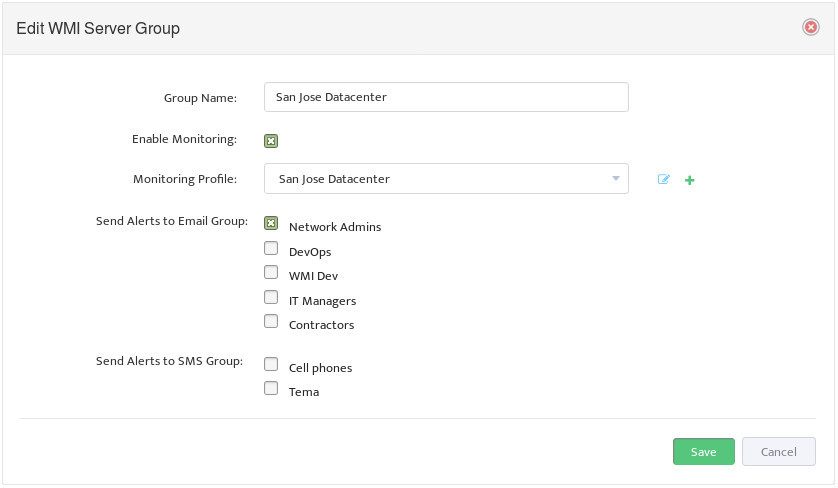
Select the WMI Monitoring Profile to use from the Monitoring Profile drop-down list.
Check the Enable Monitoring box to begin monitoring the Server Group using this Monitoring Profile.
7. Viewing a Storage Utilization Graph
To view a graph of Storage Utilization over time, right-click the Server you want information on and select Disk Used Space Graph.
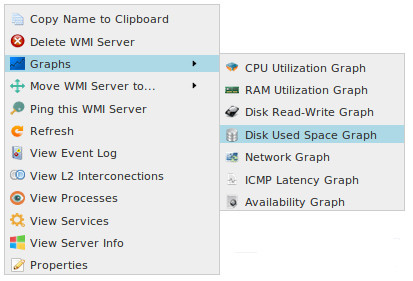
This opens a “Disk Used Space Graph” which displays the changes in Storage Utilization over time.
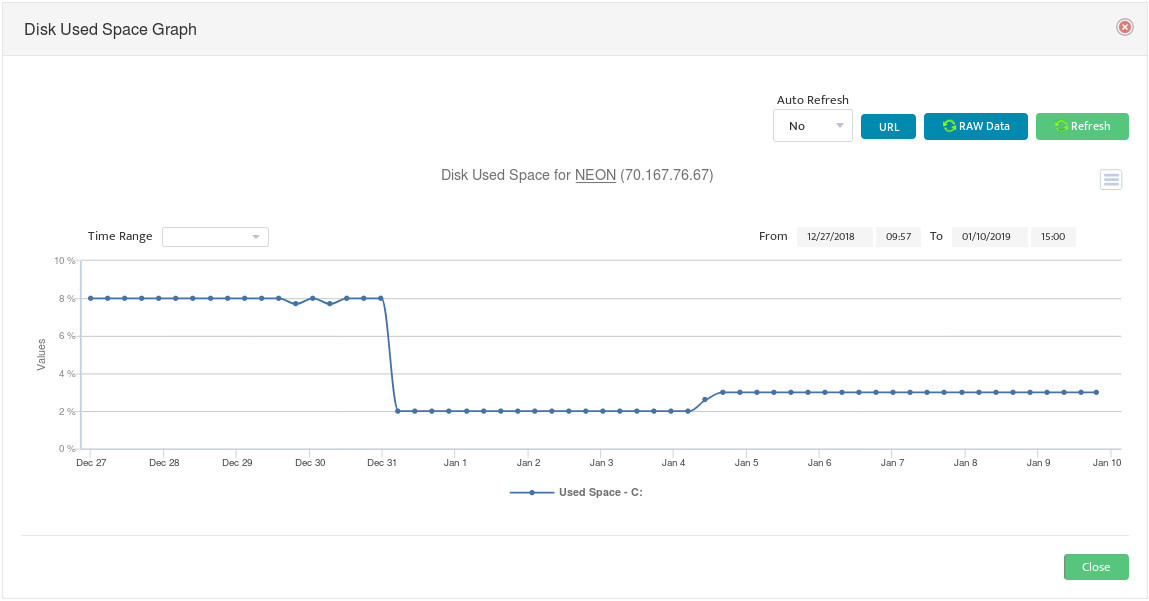
List of system variables that can be used in Alert emails for SNMP Devices and Interfaces (Version 2.48, January 2019).
More system variables will be added in next releases.
Device Hostname: %dev_hostname%
Device IPv4 Address: %dev_ipv4_address%
Device IPv6 Address: %dev_ipv6_address%
Device CPU Utilization: %dev_cpu_utilization%
Device RAM Utilization: %dev_ram_utilization%
Interface Name: %interface_name%
Interface Description: %interface_description%
Interface Rx Utilization: %interface_rx_utilization%
Interface Tx Utilization: %interface_tx_utilization%
Device Site: %dev_site_name%
Alert Time: %time%
Outage Duration: %outage_duration%
How to Configure Nectus Syslog Collector to use Local Storage
- To configure Nectus Syslog collector storage settings go to Main Menu
Settings → General Settings → Syslog Settings
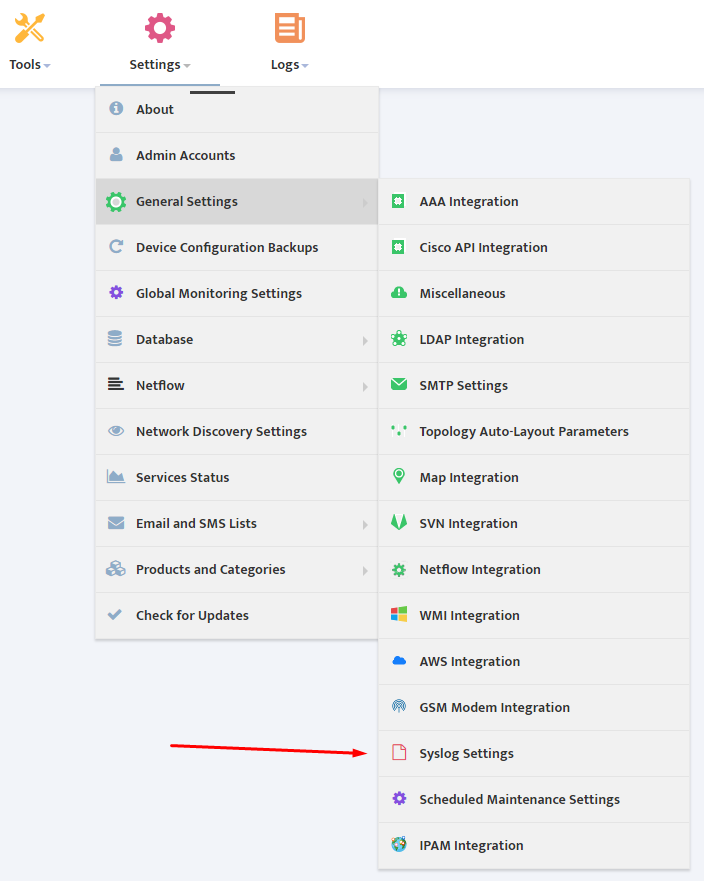
- Configure Storage parameters according to this example:
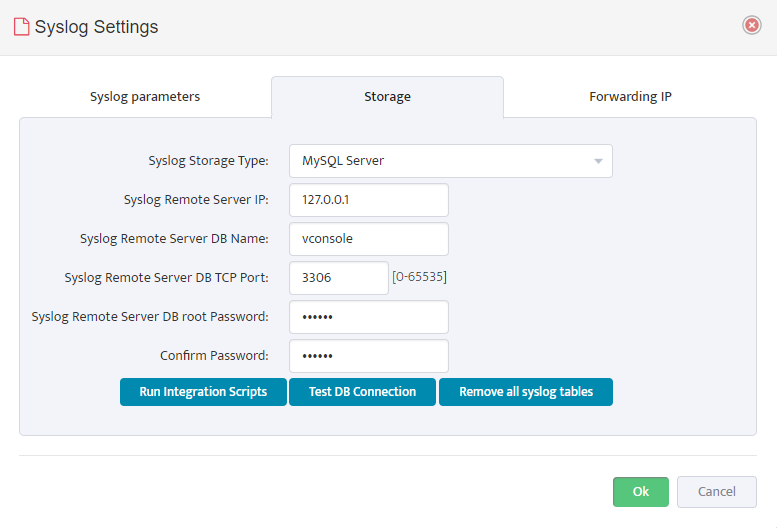
“Syslog Remote Server DB Root Password” should be taken from this file:
C:\Program Files\Nectus\Web\Apache24\htdocs\protected\config\database.ini
- After Configuration is finished press “Test DB Connection” to test connectivity to DB
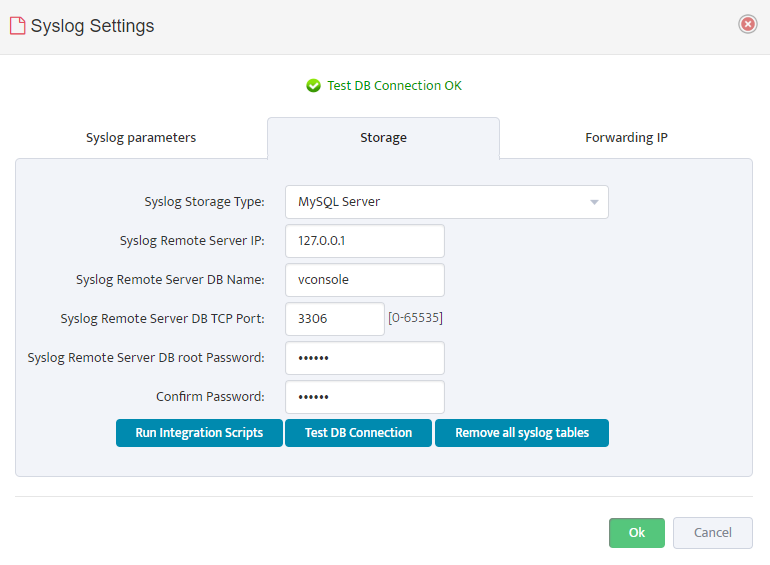
- After DB connectivity is Tested, Press “Run Integration Scripts” button to create required SQL Tables.
- After Integration Scripts has been executed, Restart Syslog collector service in
“Settings → Services Status”
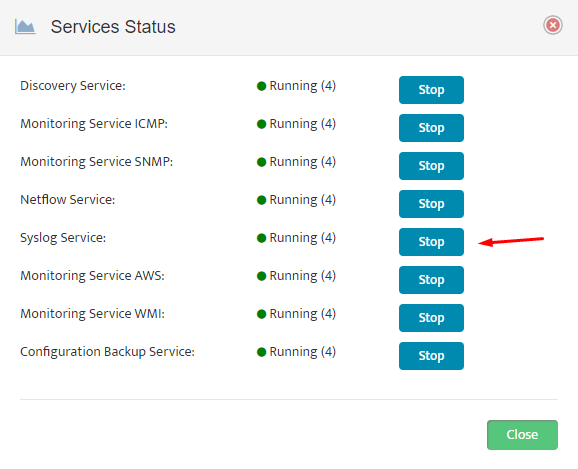
After Syslog Service is Restarted it should be ready to process and store Syslog Traffic.
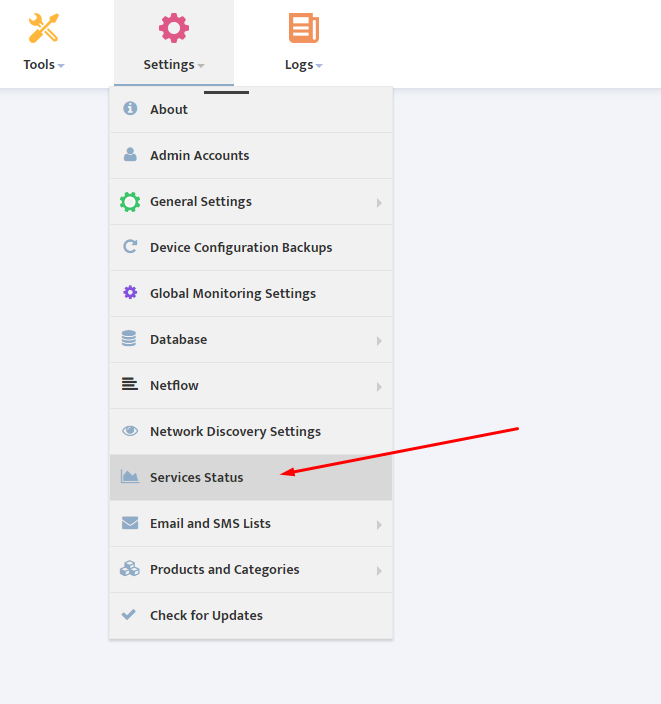
How to Configure Nectus NetFlow Collector to use Local Storage
To configure Nectus Netflow collector storage settings go to Main Menu
Settings → General Settings → NetFlow Integration
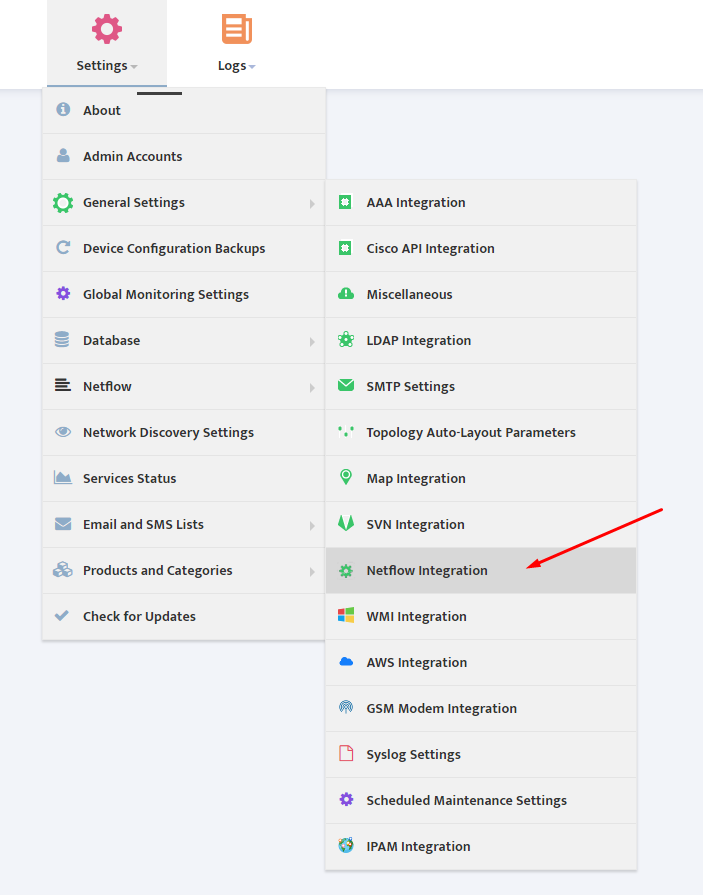
Configure Storage parameters according to this example:
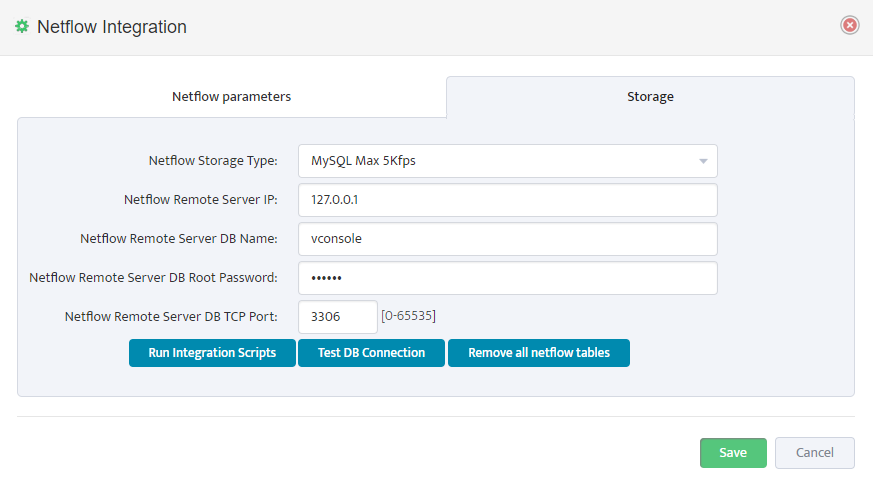
“NetFlow Remote Server DB Root Password” should be taken from this file:
C:\Program Files\Nectus\Web\Apache24\htdocs\protected\config\database.ini
After Configuration is finished press “Test DB Connection” to test connectivity to DB
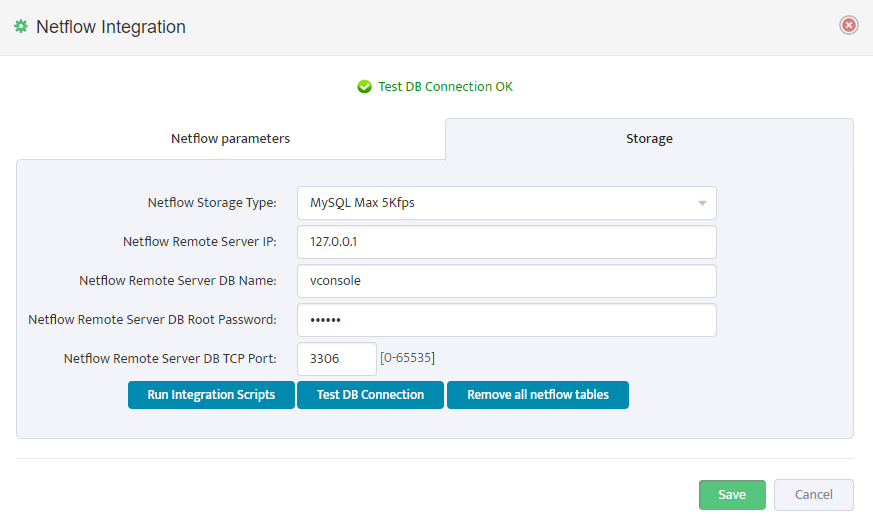
After DB connectivity is Tested, Press “Run Integration Scripts” button to create required SQL
Tables.
After Integration Scripts has been executed, Restart NetFlow collector service in
Top menu “Settings → Services Status”
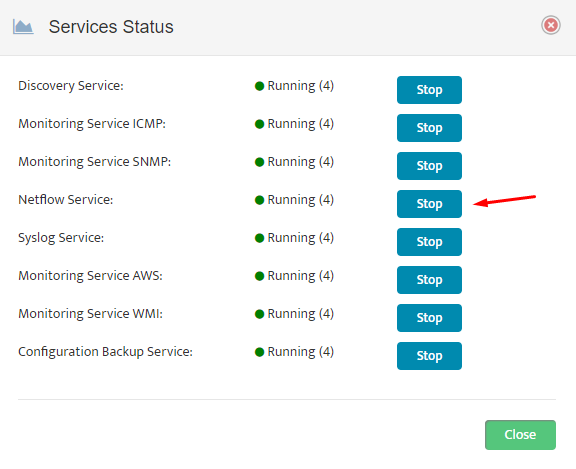
After NetFlow Service is Restarted it should be ready to process NetFlow Traffic and store it in local DB.
Monitoring Scope Utilization on Windows DHCP Servers with Nectus
In this chapter, you’ll learn how to use Nectus to enable and configure DHCP Scopes utilization monitoring on Windows DHCP Servers.
Nectus allows network engineers proactively monitor amount of free IP addresses in DHCP scopes and generate E-mail or Text alerts when number of free IP address falls below preset thresholds.
Nectus can also generate alert when number of free IP address exceeds predefined threshold as it may indicate underlying network operation problems when network devices not able reach DHCP server for leases.
Nectus uses basic WMI interface to collect scope and lease statistics from DHCP servers.
The specific topics we will cover in this chapter are:
- What is WMI?
- Why Monitor DHCP Scopes?
- Creating a DHCP Server Group
- Adding DHCP Server to Server Group
- Creating and Configuring Monitoring Profile
- Assigning Monitoring Profile to Server Group
1. What is WMI?
Nectus uses Windows Server WMI interface to collect basic information about DHCP scopes such as total number of IP addresses and current number of active leases.
WMI (Windows Management Instrumentation) is a set of specifications and interfaces that provides information about the status of local and remote computers running Microsoft Windows. In this chapter we look at how Nectus uses WMI to monitor DHCP Scope Utilization and send alerts based on that information.
Note: WMI is the Microsoft implementation of the Web-Based Enterprise Management (WBEM) standard and the Common Information Model (CIM) standard from the Distributed Management Task Force (DMTF).
2. Why Monitor DHCP Scopes?
Availability of free IP addresses is a critical requirement for modern network. When DHCP scope runs out of addresses users are not able to join your network.
Typical network segments that heavily dependent on DHCP are LAN and Wi-Fi Users.
Several DDOS attack types are specifically targeting DHCP infrastructure and by exhausting DHCP pools with fake lease requests can bring down any network to its knees.
Sometimes regular business growth can cause corresponding grows in IP address utilization and if left undetected can eventual cause an outage and service degradation for DHCP dependent applications.
3. Creating a DHCP Server Group
First step is to create a new Server Group for our DHCP Servers.
Go to the Nectus Home Screen and select WMI Servers -> WMI Servers. In the menu that appears, click Add New Group.

This opens the “Add New WMI Server Group” dialog box.

Complete the fields that define the new Group and set Enable Monitoring.
4. Add a DHCP Server to Server Group
Now we need to define our DHCP Server and add those to Server Group.
To add a Windows DHCP Server to the Server Group right-click the Group and select Add New WMI Server.

This opens the “Add WMI Server” dialog box.

Enter the IP address of the Server you want to add to the Group.
Note: You can move a Server between different Groups by right-clicking the Server and using the Move WMI Server to option.
5. Creating and Configuring Monitoring Profile
Monitoring Profile is a list of Metrics that can be applied to Server Group to tell Nectus which specific metrics must be monitored for given Server Group.
To create new Monitoring Profile to go Monitoring -> WMI Monitoring Settings and press
“Add Profile” button
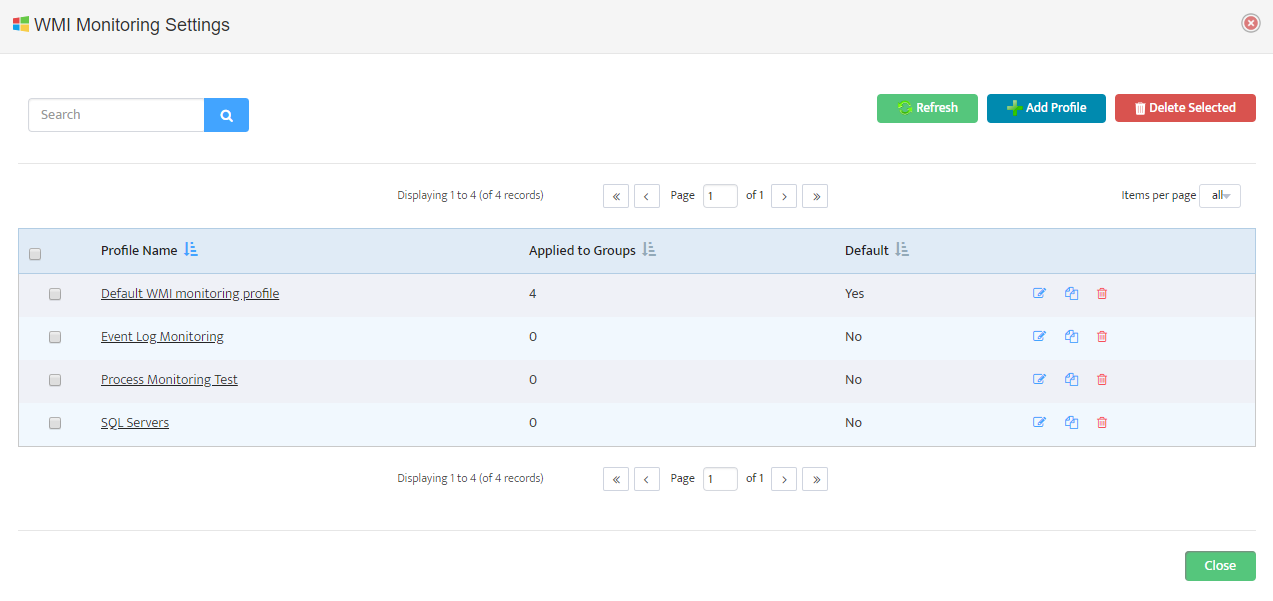
Monitoring Profile Configuration Interface will appear.
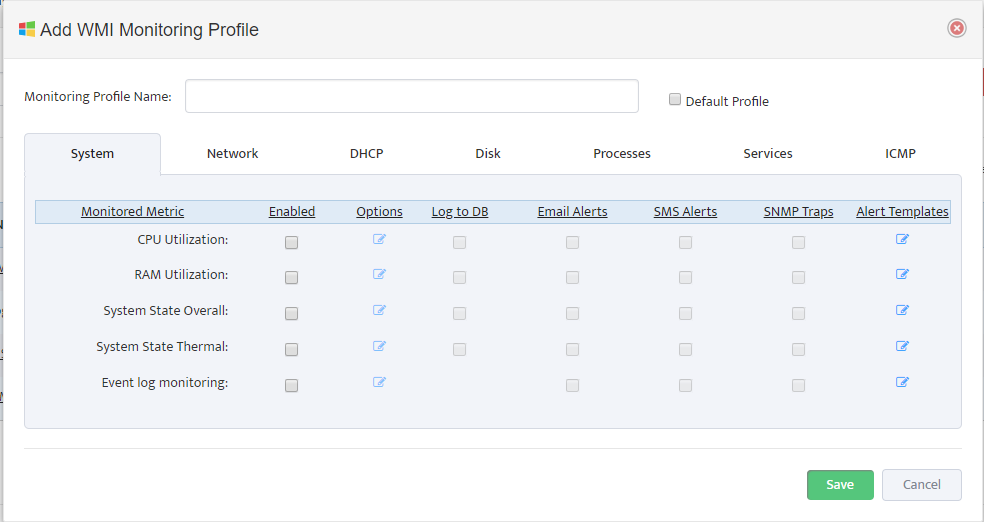
Assign Profile Name and enable “DHCP Scope Usage” check-button on “DHCP” Tab
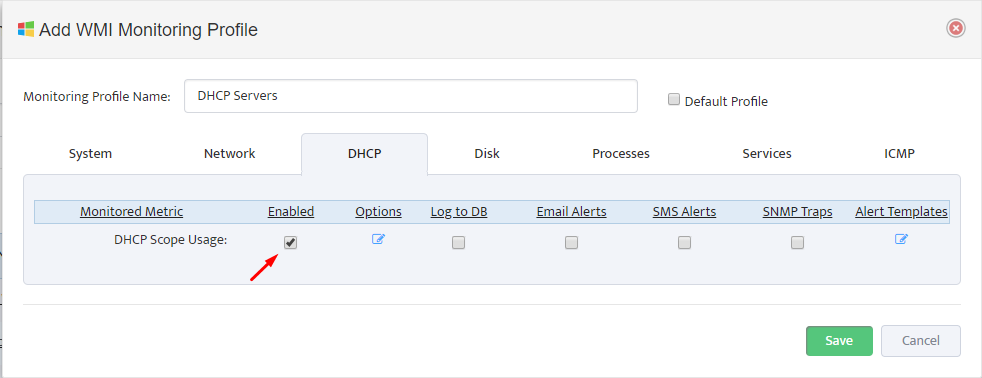
Configure Max/Max Threshold Values for Alerts by pressing on “Options” button
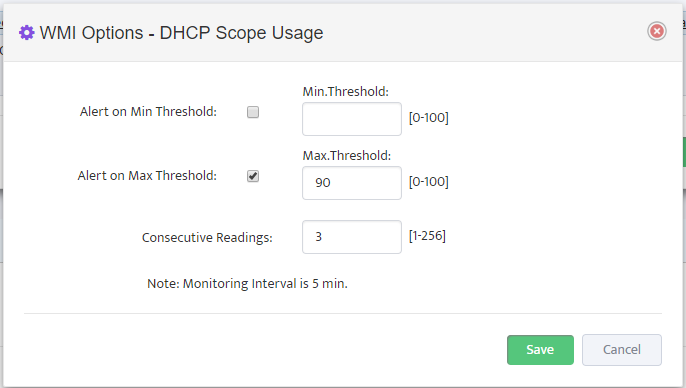
Note: Monitoring Interval is 5 min therefore 3 for “Consecutive Readings” value will trigger Alert
only if Threshold condition are True for 15 minutes.
6. Assigning Monitoring Profile to Server Group
Next and the final step is to assign Monitoring Profile to the DHCP Server Group that we created.
Right Click on DHCP Server Group in left side panel and Select “Properties”
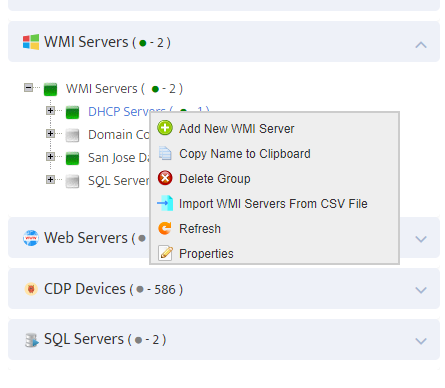
Select Monitoring Profile from the list of available Profiles and Click on “Enable Monitoring” check-button.
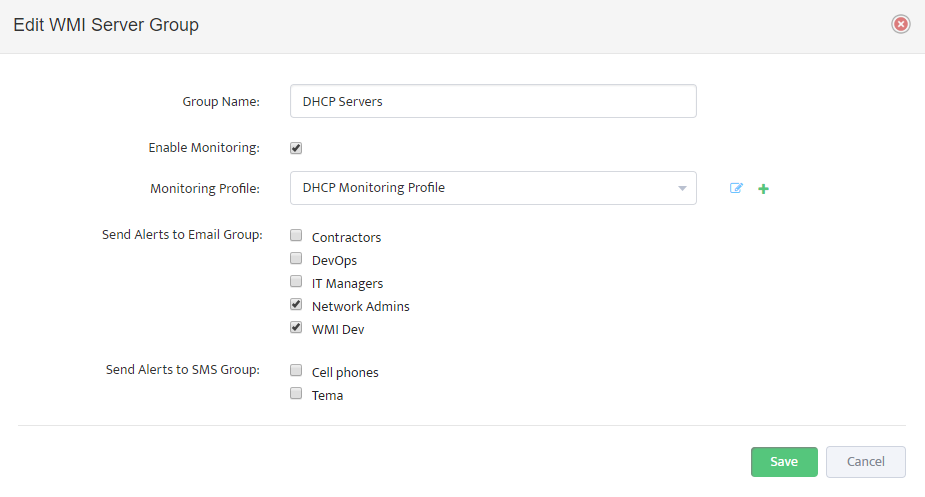
We are all set and ready to start proactive monitoring of your DHCP Infrastructure.
Download the best IPAM https://www.nectus5.com/download/
Importing subnets to IPAM from IGP routing protocols
Most existing IPAM tools require manual subnet configuration, which is by far the most time-consuming step in IPAM deployment. Nectus offers unique automated features that make the initial configuration fast and easy. One such feature is an automatic import of subnets from the IGP routing protocols like OSPF, EIGRP, or ISIS. Here is how it’s done.
Importing subnets to IPAM from IGP
In the Main Menu, go to Inventory → IMAP Subnets and Reservations.
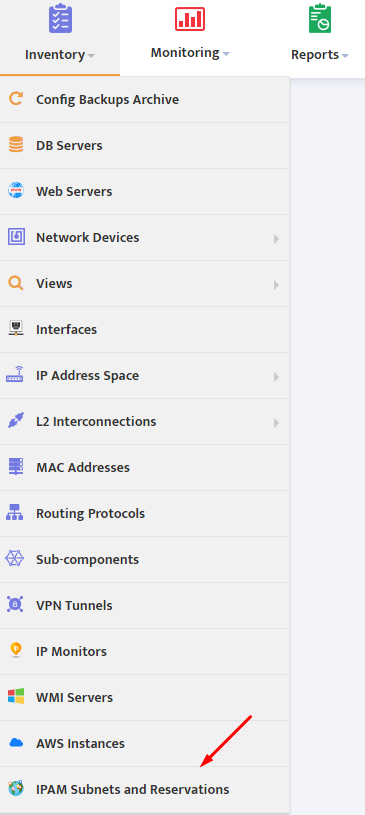
This opens an “IPAM Subnets” window with “IPv4 subnets” tab. Click the Import Subnets from Routing Table button.
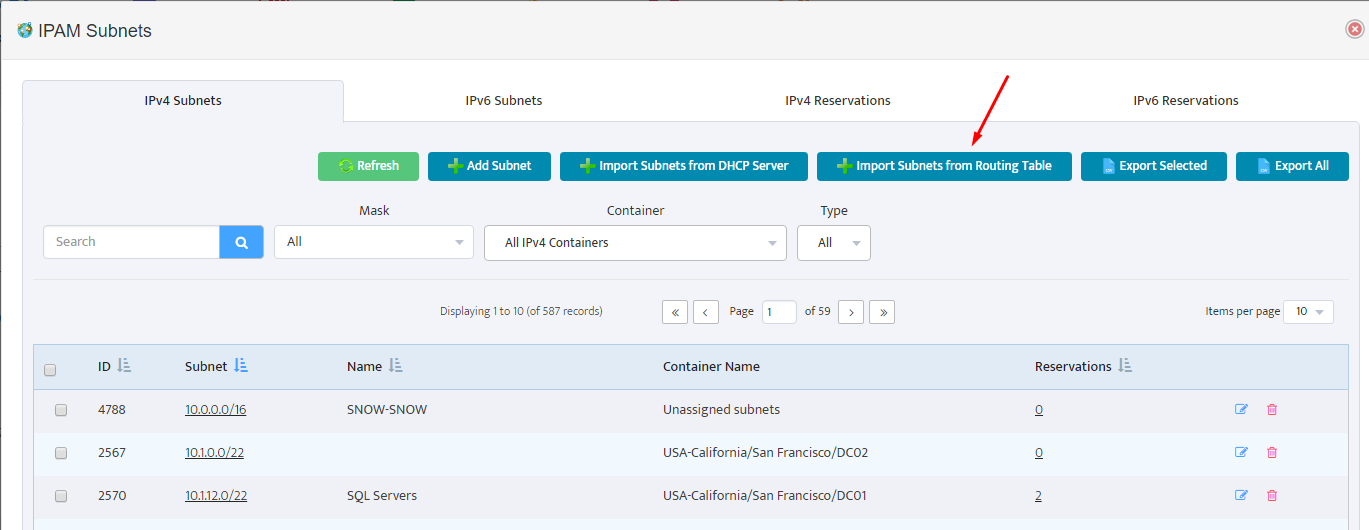
In the “Import Subnet from IGP” dialogue box that appears, specify the IP address of the backbone router from which you’ll be importing subnets, and a destination IPAM container where the imported subnets will be placed. Press the Import button to preload the subnets.
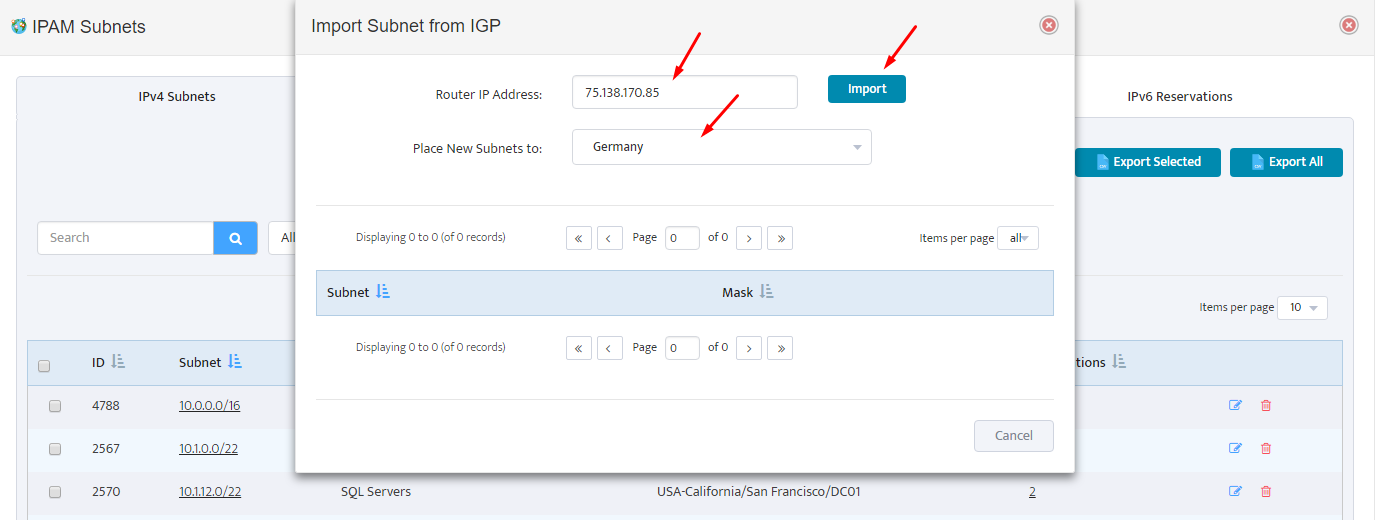
Nectus displays preloaded subnets in a table format, for your confirmation. Press Yes button to confirm import of subnets, and they will automagically appear in the designated IPAM container.
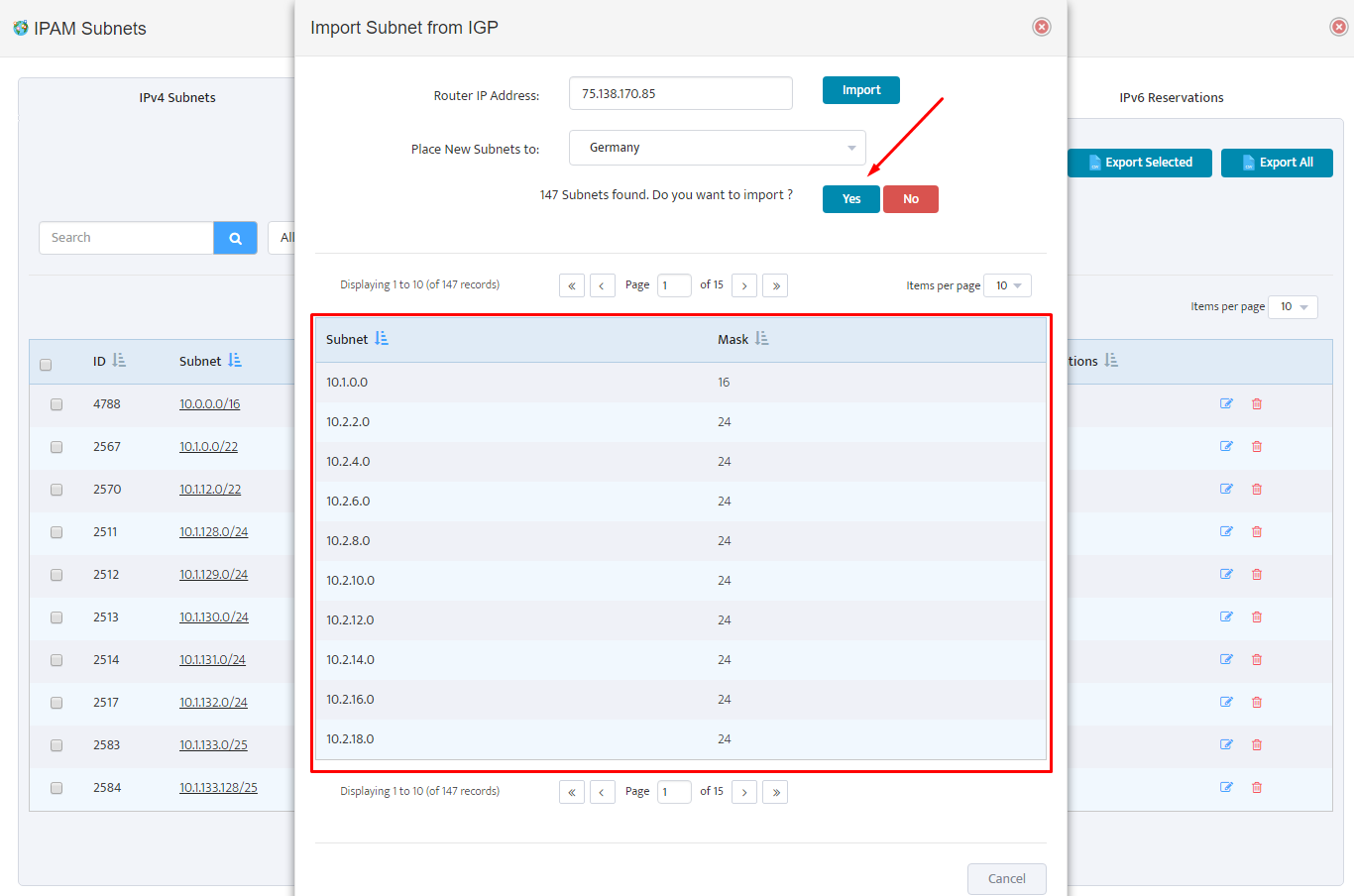
Importing subnets to IPAM from DHCP servers
One of the most time-consuming steps in IPAM deployment is initial configuration. Whether you have 5 or 1000 network subnets, most IPAM software products require manual configuration of subnets. Nectus offers unique automated features that make this initial configuration step fast and easy. One such feature is an automatic import of the subnets from the DHCP servers, which is done in 2 quick steps.
Adding DHCP servers to IPAM
Begin the process by configuring the DHCP servers on “IPAM integration” page. In the Main Menu, select Settings → General Settings → IPAM Integration.
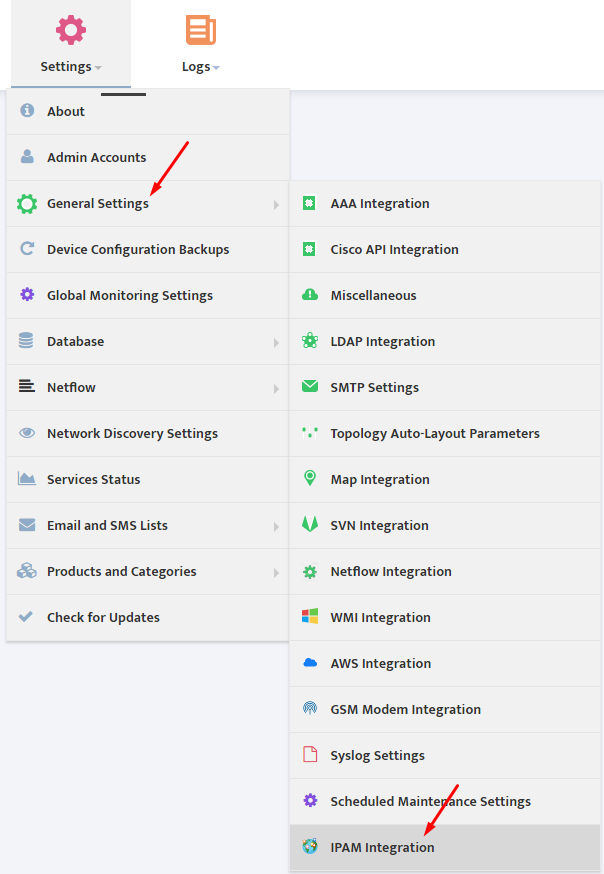
This opens an “IPAM Integration” page. To add DHCP servers to IPAM, select the DHCP Servers tab and press the Add button to open the “Add DHCP Server” dialogue box. Fill in the server name, IP address and Type, and press the Save button for each DHCP server you want to add to IPAM.
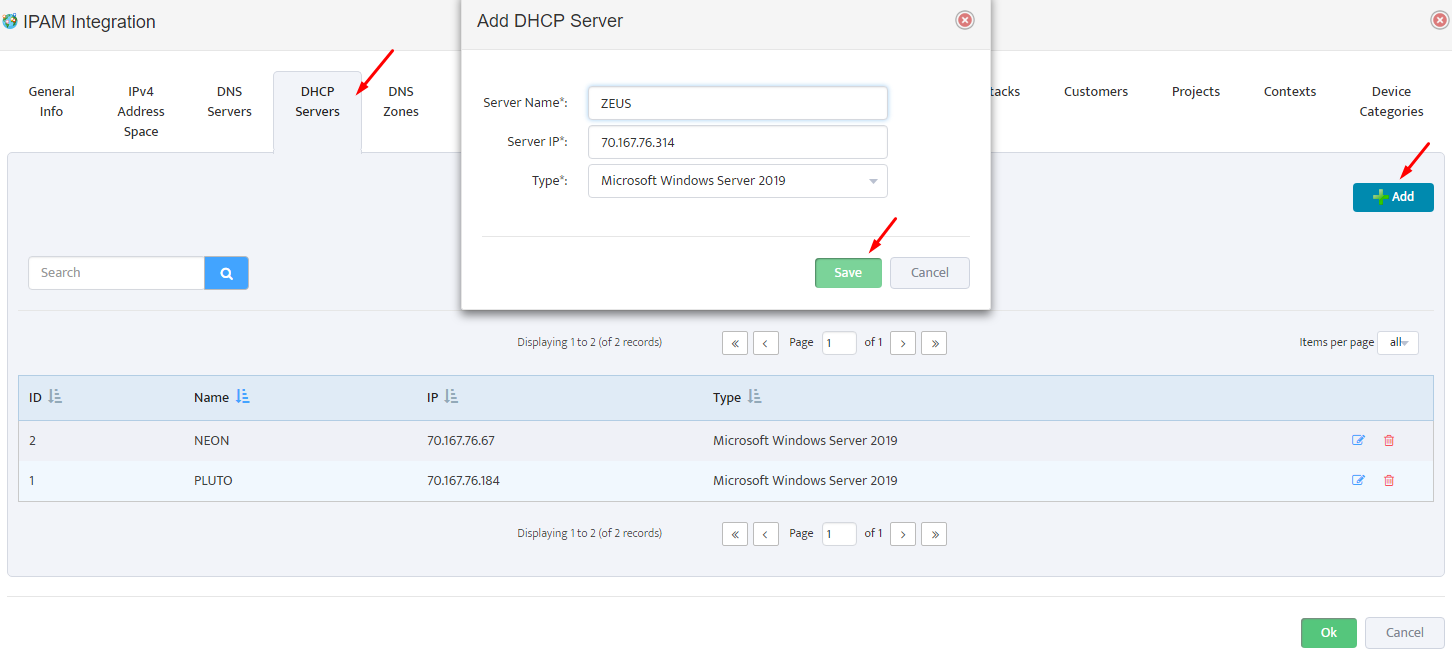
Importing Subnets from DHCP Servers to IPAM
Once the DHCP servers are configured, you are now ready to start importing subnets. In the Main Menu, go to Inventory → IMAP Subnets and Reservations.
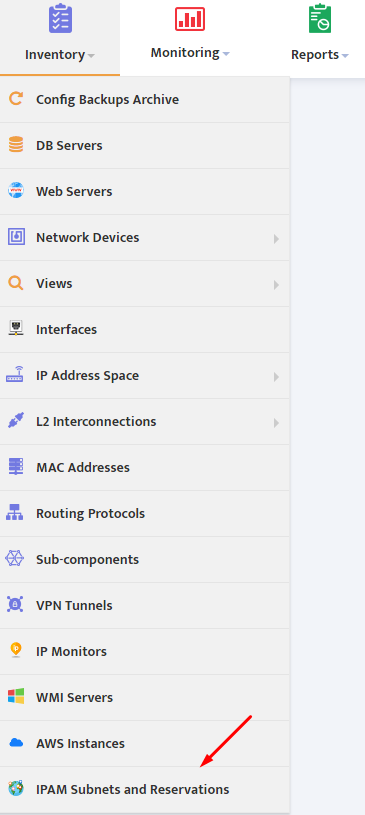
This opens an “IPAM Subnets” window with “IPv4 subnets” tab. Click the Import Subnets from DHCP Server button to open the “Import Subnet from DHCP Server” dialogue box.
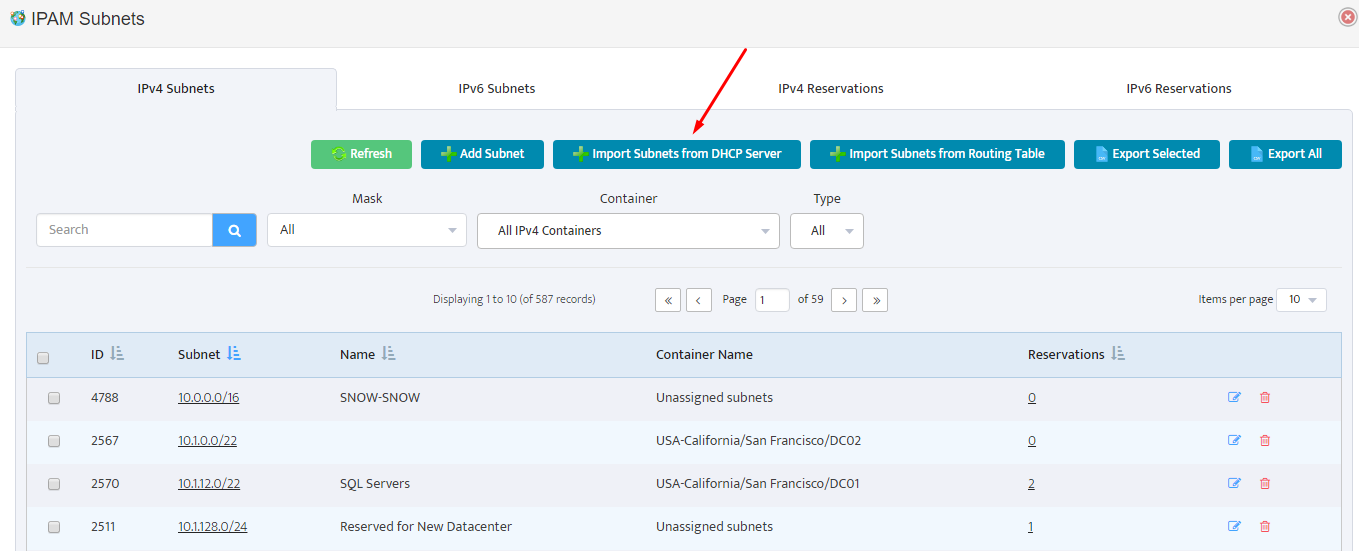
Select the DHCP servers from which you’ll be importing subnets, and a destination IPAM container where the imported subnets will be placed. Press the Import button to preload the subnets.
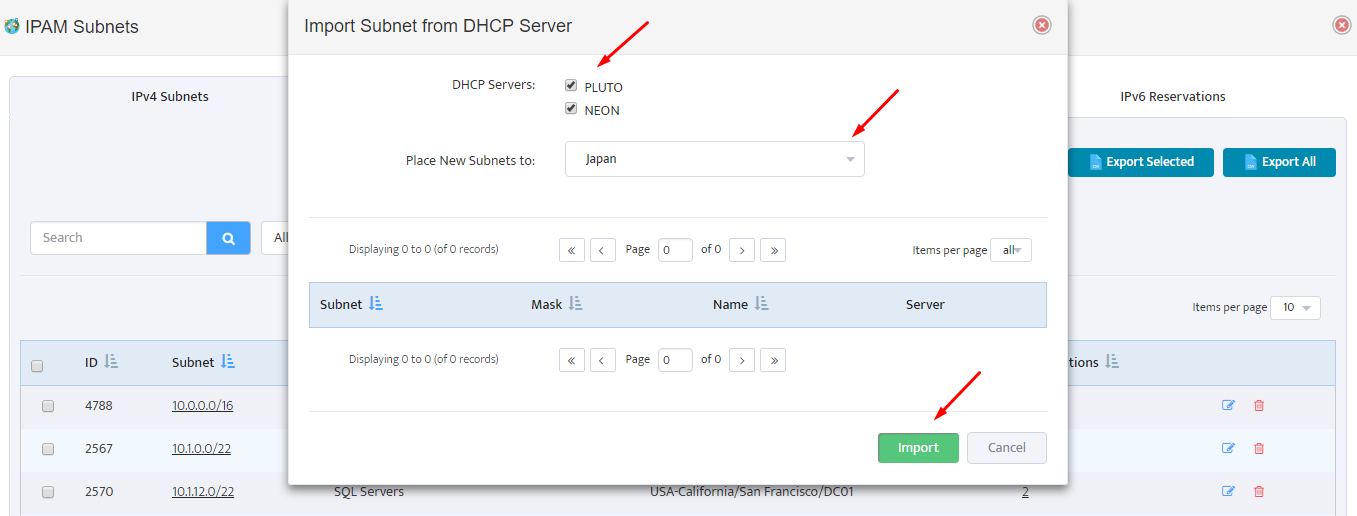
Nectus displays preloaded subnets in a table format, for your confirmation. Press Yes button to confirm import of subnets, and they will automagically appear in your designated IPAM container.
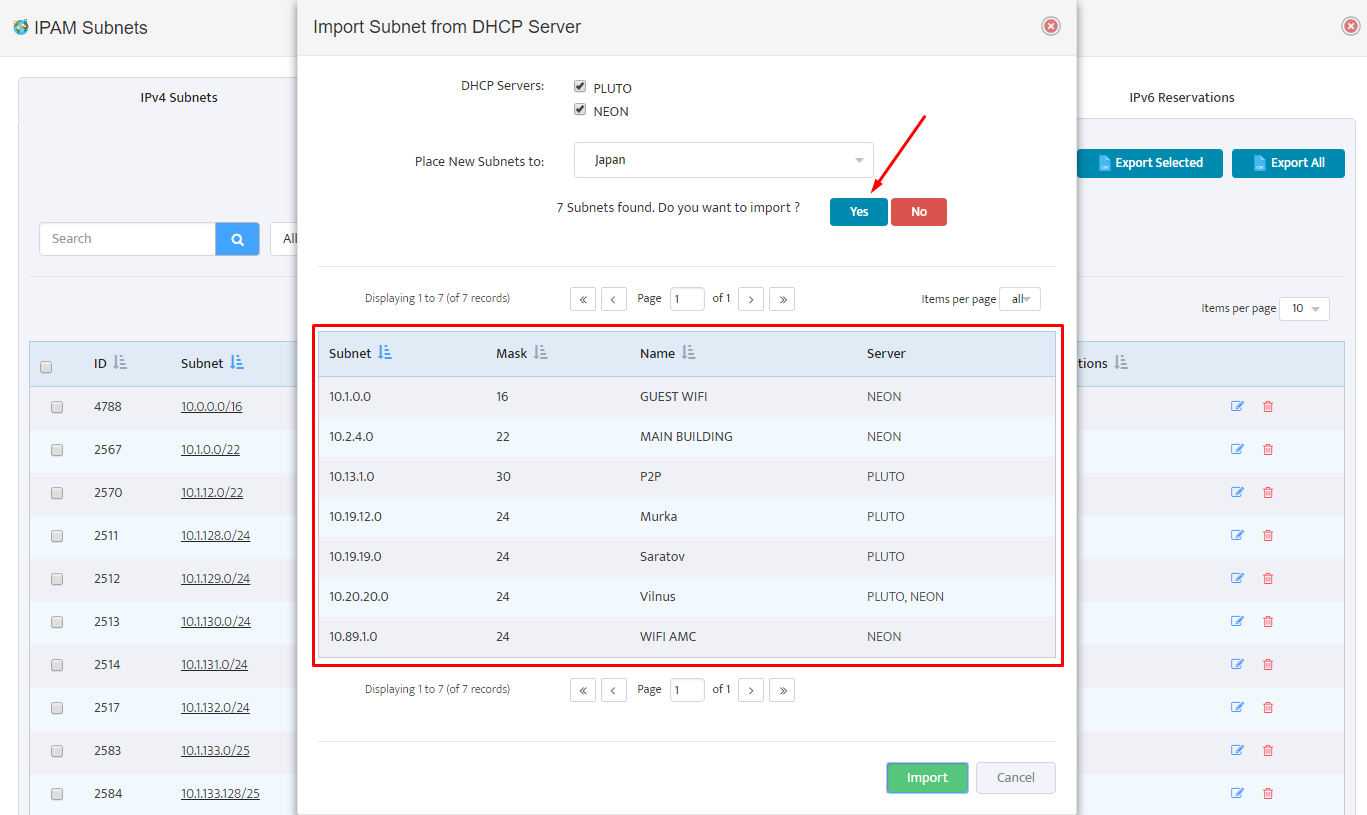
Management Interface Selection for Network Devices
In this chapter, you’ll learn how Nectus selects Management Interfaces for Devices that are found during Discovery phase. Nectus will automatically select Management Interfaces using its own default logic. It also supports user-defined selection for cases where this is appropriate.
The specific topics we will cover in this chapter are:
- Default Logic for Management Interface Selection
- User-Defined Logic for Management Interface Selection
- Applying Selection Rules to Existing Devices
1. Default Logic for Management Interface Selection
During Discovery, Nectus finds all SNMP Devices on the network. Every Device has one or more Interfaces. Some of those Interfaces will have IP Addresses assigned to them, and could be used as the Management Interface for that Device.
Nectus has default logic for selecting the Management Interface for each Device. It checks every Interface on a Device looking for potential Management Interfaces. To be considered for selection as the Management Interface, an Interface must meet the following requirements:
- It must have a unique IP Address. Nectus will not select an Interface that does not have an IP Address, or that has an IP Address identical to some other Interface on the network.
- It must be Up. Netus will not select an Interface that is not Up.
From this list of possible Management Interfaces, Nectus selects one according to this priority list:
- An Interface name that begins with Mgmt
- An Interface name that begins with Loopback
- An Interface name that begins with Vlan
- Interface with lowest IP Address
If Nectus finds an Interface name that begins with Mgmt, it will use this as the Management Interface. If it does not find an Interface name that begins with Mgmt, it will look for one that begins with Loopback, and so on.
If Nectus does not find an Interface whose name starts with Mgmt, Loopback, or Vlan, it will select the lowest numbered IP Address on the Device.
This default logic allows Nectus to automatically select the correct Management Interface in most situations. To handle situations where the default logic is not appropriate, Nectus supports user-defined logic for Management Interface selection.
2. User-Defined Logic for Management Interface Selection
Defining your own Management Interface selection logic makes sense in two situations:
- When the naming convention for your Interfaces doesn’t match the default rules
- When specific Interfaces have special naming requirements
When a Device has applicable user-defined Management Interface selection logic, Nectus looks for that Interface before applying the default logic. As with the default logic, user-defined Management Interfaces:
- Must have a unique IP Address.
- Must be Up.
To create user-defined logic for a specific Device type right-click the Device name. In the menu that appears, select View Device Info.
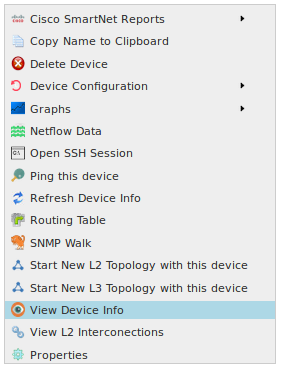
This opens the “View Device Info” dialog box.
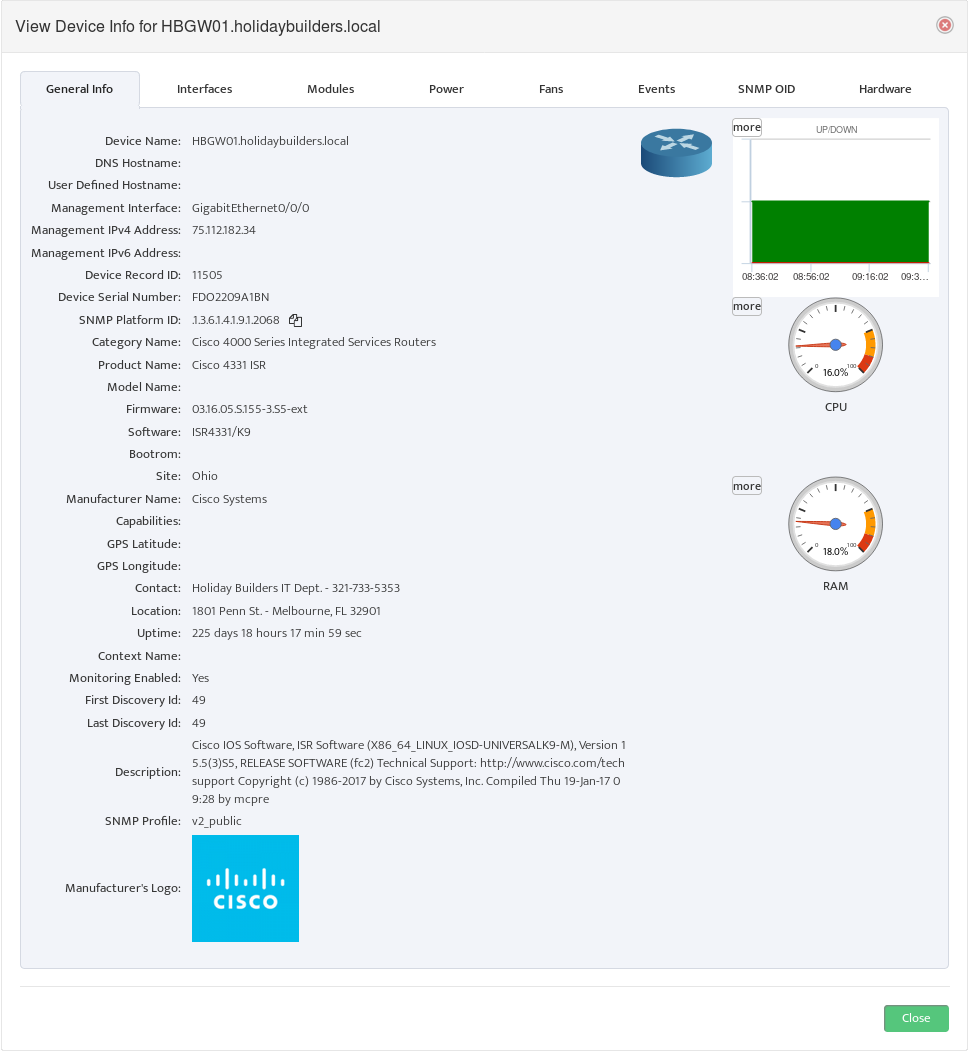
On the General Info tab, find the SNMP Platform ID and click the icon to the right of it to copy the ID.
Note: All Devices with the same model number have the same SNMP Platform ID.
Next Step is to go to Settings -> Products and Categories -> SNMP OID Libraries.
Select SNMP OID Libraries.
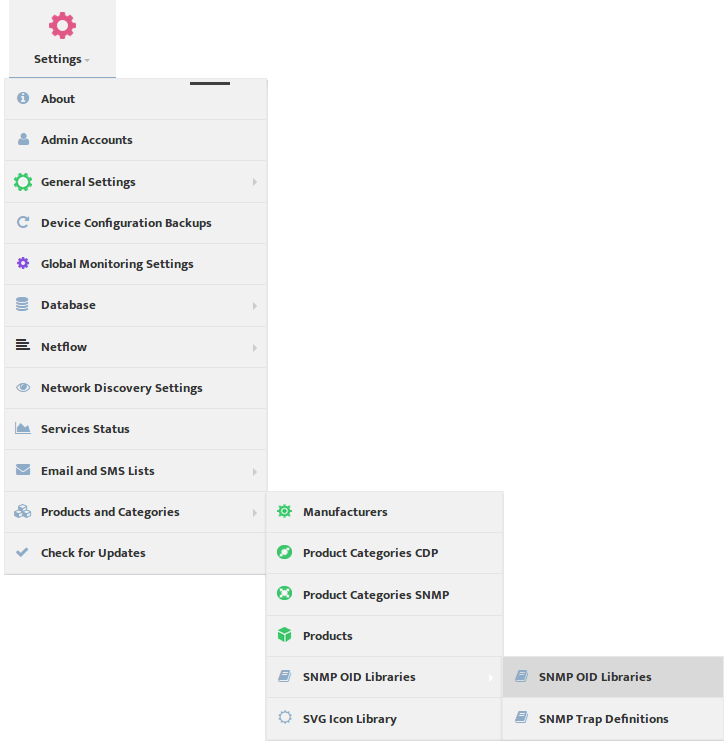
This opens the “SNMP OID Libraries” dialog box.

Select Management Interface Name in the Filter by OID Type list. Nectus displays all the current user-defined Management Interface Selection rules.
Click the Add button to open the “Add” dialog box.

Enter the SNMP Platform ID and the Management Interface Name Nectus should use for this type of Device.
3. Applying Selection Rules to Existing Devices
Defining new Management Interface selection rules will have automatic effect on all devices that will be discovered after rule is created but does not automatically apply those rules to existing Devices.
You need to tell Nectus to apply those changes to existing Devices.
To apply the user-defined selection rules to existing Devices, return to the “SNMP OID Libraries” dialog box and click the “Apply to Existing Devices” button.
This is basic configuration example of the SNMPv3 on IOS device.
This enables SNMP v3 with following parameters:
Authentication Protocol: MD5
Authentication Username: vconsole
Authentication Password: nectus
Privacy (Encryption) Protocol: AES-256
Privacy (Encryption) Password: nectus
Configuration Example
====================
snmp-server group NECTUS_V3_GROUP v3 auth read TESTv3
snmp-server view TESTv3 mib-2 included
snmp-server user vconsole NECTUS_V3_GROUP v3 auth md5 nectus priv aes 256 nectus
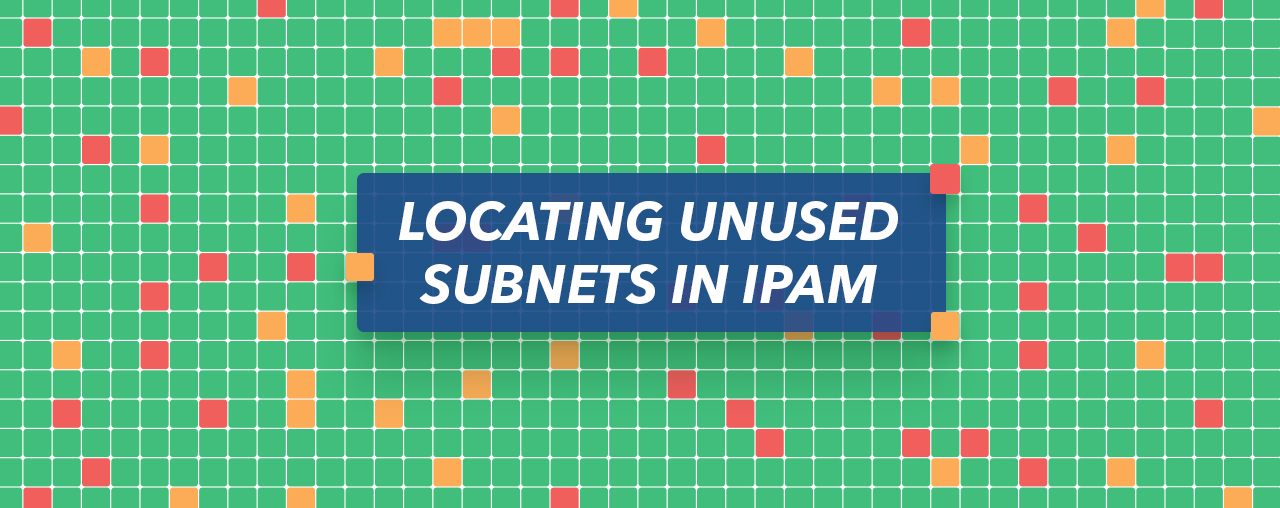
Locating Orphaned IPAM Subnets
One of the key features of good IPAM is ability quickly find subnets that are part of the defined address space but have not been explicitly added to list of subnets available for allocation.
These subnets are normally called “orphaned” and can be presented as white spaces within address space.
Orphaned subnets are normally occurring when you import IPAM subnets from external source such as IGP routing table where address space is not contiguously divided among all the existing subnets.
Lets looks at this simplified example of the logic required for locating orphaned subnets.
For example, user defined full address space as 10.0.0.0/8 (10.0.0.0 – 10.255.255.255)
and imported one subnet from IGP: 10.20.20.0/24 (10.20.20.0 – 10.20.20.255)
We can present full address space as a contiguous line starting from 10.0.0.0 and ending 10.255.255.255
Full IPv4 Address Space:
10.0.0.0 ———————————————————————————-10.255.255.255
Now let’s overlay single imported subnet into address space line:
10.0.0.0 ————-***Used*** —————————————————10.255.255.255
We see that there is some unused space to the left and to the right of the used space.
We need to find all the subnets that cover unused space so they can be presented in IPAM list of available subnets. The subnets that we are looking for must be largest subnets possible,
to minimize fragmentation.
Let’s summarize: Our goal is to find the largest subnet(s) that can be fit into the left and right empty segments.
Let first look at “left” empty space:
| First IP | 10.0.0.0 | 00001010.00000000.00000000.00000000 |
| Last IP | 10.20.19.255 | 00001010.00010100.00010011.11111111 |
We can see that First and Last IP address of “left” empty segment have matching highest 11 bits.
Largest subnet that will fit into “left” empty segment will have First and Last IP with following parameters:
First IP address:
- Has 00001010.000 in first 11 bits
- Has all zeros in Host portion
- Is greater or equal to 10.0.0.0
Last IP address:
- Has 00001010.000 in first 11 bits
- Has all ones in Host portion
- Is less or equal to 10.20.19.255
After checking all possible options matching IP addresses are discovered.
| First IP | 10.0.0.0 | 00001010.00000000.00000000.00000000 |
| Last IP | 10.15.255.255 | 00001010.00001111.11111111.11111111 |
This combination of First/Last IP gives us largest Subnet that will fit into “left” free segment as 10.0.0.0/12
We can see that 10.0.0.0/12 does not fully cover “left” empty segment so this discovery process has to be repeated for remaining empty space. Discovery may require several iterations until we get 100% coverage.
Similar approach must be applied to “right” empty segment until we identify all orphaned subnets and achieve 100% coverage of required address Space.
If your IPAM can’t perform this type of Discovery, you know where to download the best IPAM on the market: https://www.nectus5.com/download/
Splitting and Merging Subnets in IPAM
In this chapter, you’ll learn how and why to Split and Merge Subnets.
The specific topics we will cover in this chapter are:
- Why Split and Merge Subnets?
- How to Split Subnets
- How to Merge Subnets
- How to Move Subnets
1. Why Split or Merge Subnets?
Splitting and Merging Subnets lets you use your IP address space more efficiently. A full Class C Subnet has 256 usable addresses. But if you only need 30, using the full Subnet would result in a waste of over 200 IP addresses. Splitting the subnet would allow you to get the number of addresses you need, without wasting the rest. In addition, making a smaller Subnet reduces network traffic, as messages on that Subset are broadcast to fewer addresses.
Merging Subnets works the opposite. You may need a Subnet with 80 IP addresses, but instead have several smaller Subnets available. By merging smaller Subnets into one large one, you can use those addresses that might otherwise be wasted.
Nectus also allows you to move Subnets to different IPAM Containers. This makes it easy to reallocate IP addresses from their current location to the physical Sites that need them.
2. How to Split Subnets
To Split a Subnet go to the Nectus Sites Panel and select IPAM > All IPv4 Containers.

Nectus displays all existing IPAM Containers and any Unassigned Subnets. To see how many IP addresses are available in any Subnet, right-click it. In the menu that appears, select View Subnet Info.

This opens the “Subnet View Info” dialog box.

The Total IPs field on the General Info tab shows how many IPs the Subnet contains.
Navigate to the Subnet you want to split and right-click it. In the menu that appears, select Split.
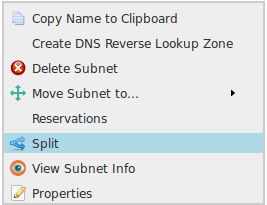
This opens the “Split Subnet” dialog box.
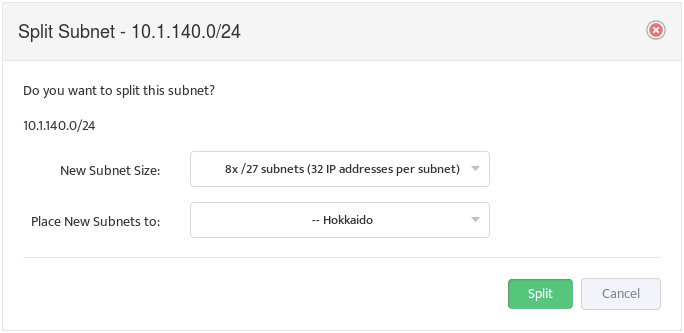
The New Subnet Size list shows you the ways you can split the selected Subnet.
The Place New Subnets to: list allows you to assign the new Subnets you create to any existing IPAM Container.
3. How to Merge and Subnets
To Merge two or more Subnets go to the Nectus Sites Panel and select IPAM > All IPv4 Containers.
Navigate to the Subnets you want to merge and select each one. The Subnets you want to Merge must be contiguous, as in the screenshot below. Right-click one of the Subnets and in the menu that appears, select Merge Subnets.

This opens the “Merge Subnets” dialog box. The dialog box shows you which Subnets will be merged, and gives you the option to place the merged Subnet in any IPAM Container.
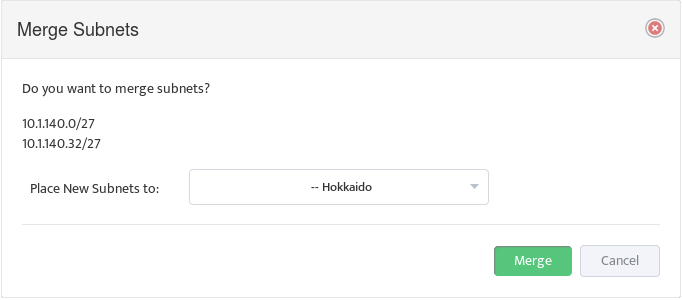
4. How to Move Subnets
You can move a Subnet without Splitting or Merging it. To move a Subnet to a different IPAM Container right-click the Subnet.
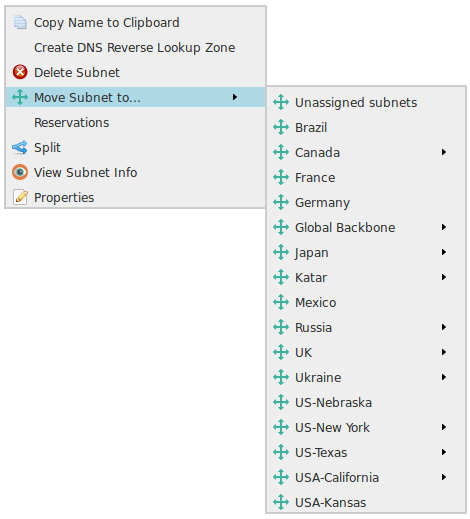
In the menu that appears, select Move Subnet to… and navigate the list of Containers to select the new location.
IPAM initial configuration automation: Subnets
As soon as you install your favorite Nectus IPAM solution the first question that comes to your mind is “How do I add all of the existing Subnets into new IPAM”?
Let’s see what automation options does Nectus offer to ease your initial deployment pains.
There are three primary places where your existing subnets can be imported from
- IGP Routing Tables (ISIS, EIGRP, OSPF, RIP)
- DHCP Servers
- Excel Spreadsheets
Importing from IGP
Importing most of your subnets from IGP is the primary way to get most (if not all) of your subnets into IPAM in a single click of the button. Just right click on IPAM container Tree and select “Import Subnets from Routing Table” Option.

Provide your Core Router’s IP Address and press “Import” button

Nectus will download IGP routing table from core router via SNMP and add each subnet into IPAM database. When importing subnets from IGP Nectus starts loading subnets starting from
smallest (/32) to biggest (/8 and higher). Each new added subnet is validated against overlapping with any of the existing IPAM subnets.
This logic ensures that summarized prefixes that are present in the routing table will not be added to IPAM.
Nectus does not import any BGP subnets to prevent public Internet prefixes leaking into IPAM.
You can repeat IGP Import several times with different Core routers if there is a reason to believe that different Core routers may produce different set of subnets.
Importing from DHCP Servers
Importing subnets from DHCP Servers works similarly to IGP Import. Right Click on any of the IPAM containers and Select “Import Subnets from DHCP” Option.
Nectus load all the DHCP pools from all the DHCP servers configured in “IPAM Integration” page and add those into IPAM database if they have not been already added during IGP Import Phase.
All the subnets imported from DHCP Servers are validated against overlapping with any of the existing IPAM subnets.
Currently DHCP Import is only supported for Microsoft Windows DHCP servers and require
operational WMI Integration configuration.
Importing from CSV Files
And final and still viable option is to Import your subnets from CSV File.
Select “Import from CSV” in context menu of any of the IPAM Containers to load your subnets from CSV File.
Finding Unused Subnets
Once you finished loading your “in-use” Subnets into IPAM next step is to identify what subnets are “available” since subnets that are not allocated yet will not be present in the IGP or DHCP Servers.
To identify unused subnets Nectus takes your Address Space Subnets defined in IPAM Global integration page and excludes all of the “in-use” subnets to calculate list of subnets that can be presented as available. All available subnets will be added to “Unassigned Subnets” default IPAM container.
Right-click on any IPAM container to access this menu option.

Making IP Reservations in Nectus IPAM
In this chapter, you’ll learn how to make IP reservations in Nectus IPAM.
The specific topics we will cover in this chapter are:
- Adding new IP reservation
- Deleting IP reservation
- Searching for IP reservations
1. Adding New IP Reservation
To create a new IP Reservation, navigate to desired Subnet in selected IPAM container
and right-click for context menu.

Click on “Reservations” option to bring up a list of current Reservations in this specific Subnet.

Switch to a “MAP” Tab to see what is available for Reservations in this subnet

Righ- Click on Selected IP on the MAP and Select “Add IPv4 To Reservation”

Fill all the desired reservation parameters and press “ADD” button

As part of IP reservation creation process you have an option to create DNS “A” Records
in forward and reverse DNS lookup zones with DNS Server configured on IPAM Integration Page.
2. How to Delete IP Reservation
To delete IP reservation right click on desired reservation on subnet MAP view Page and select “Delete Reservation” Option

As part of reservation deletion process, you can also automatically delete DNS “A” records on DNS servers if those records were previously added during reservation creation process.

3. Searching for IPAM Reservation
Best way to search for existing IP reservations is via “IPAM Subnets and Reservations” Table
located in “Inventory -> IPAM Subnets and Reservations” Page

Table view provides multiple search and filtering options for any parameters defined for IP reservations.

Managing IPAM Containers in Nectus
In this chapter, you’ll learn what IPAM Containers are and how to manage them.
The specific topics we will cover in this chapter are:
- What are IPAM and IPAM Containers?
- How to Create IPAM Containers
- How to Move IPAM Containers
- How to Modify IPAM Containers
- How to Delete IPAM Containers
1. What are IPAM and IPAM Containers?
IPAM stands for Internet Protocol Address Management. It is a system for managing the Internet Protocol (IP) address space used in a network. With IPAM you can see which IP subnets are in use and which site is using them.
The Nectus IPAM Container model allows you to create a hierarchical structure for managing subnets and mapping them to physical Sites.
2. How to Create IPAM Containers
To create an IPv4 IPAM Container go to the Nectus IPAM Panel and select IPAM -> All IPv4 Containers.

Nectus displays any existing IPAM Containers. Containers that have subnets assigned to them are displayed in green, with the number of subnets they contain appearing to the right of the Container name.
To add a new IPAM Container right-click an existing Container or All IPv4 Containers. In the menu that appears select Create New Container Level.

This opens the “Create New Container Level” dialog box.

Enter the Container Level Name and click Save. The new Container appears in the hierarchy below the location shown in Container Path:.
3. How to Move IPAM Containers
To move an IPAM Container right-click the Container Name. In the menu that appears, select Move Current Container to… and navigate the list of Containers to select the new location.

4. How to Modify IPAM Containers
To modify an IPAM Container right-click the Container Name. In the menu that appears, select Properties.

This opens the “Edit Container Properties” dialog box.

Edit the Container Level Name as desired.
5. How to Delete IPAM Containers
To modify an IPAM Container right-click the Container Name. In the menu that appears, select Delete Current Container Level.

This opens the “Delete Container Level” dialog box.

Note: Nectus will not let you delete an IPAM Container that has subnets assigned to it. If you try, Nectus displays the following message:

Configuring AD/LDAP Integration for User Authentication
In this chapter, you’ll learn how to configure Nectus to work with Microsoft Active Directory and the LDAP protocol for user authentication.
The specific topics we will cover in this chapter are:
- What are AD and LDAP?
- Why Configure Nectus Integration with AD/LDAP?
- How Nectus Authenticates Users
- Connecting Nectus to an LDAP Server
- Mapping AD/LDAP Groups to Local User Groups
- Mapping AD/LDAP Users to Local User Groups
1. What are AD and LDAP?
AD stands for Active Directory Domain Services. It is a Microsoft service that provides authentication and other services to devices on a network. It is an LDAP compliant database of users, groups, and other objects.
LDAP stands for Lightweight Directory Access Protocol. It is an Internet standard for accessing distributed directory services. Nectus uses LDAP to communicate with AD.
2. Why Configure Nectus Integration with AD/LDAP?
Configuring Nectus to integrate with AD/LDAP simplifies user management for large organizations. Like most applications, Nectus has its own local user authentication database. But when a organization has many applications maintaining separate user accounts for each application isn’t practical.
The solution is to maintain user accounts in AD. Using LDAP, each application can query the AD database for the user authentication information it needs. This greatly simplifies user account maintenance.
3. How Nectus Authenticates Users
Nectus is designed to function on its own or integrated with AD/LDAP. Security settings are based on Local User Groups whether the User Account is stored locally, or in AD.
When a user logs in Nectus first checks to see if the active user has a Local User Account. If so, Nectus uses this account for the login.
Note: To manage the Nectus Local User Accounts and the Local User Groups go to the Nectus Home Screen and select Settings -> Admin Accounts. This opens the “Admin Accounts” dialog box. See the article, “Creating User Accounts and User Groups” for details.
If the active user does not have a Local User Account, Nectus checks to see if Active Directory integration is configured. If so, it checks to see if the active user has an account in AD.
If the user has an account in AD, and the user’s LDAP Group Name is mapped to a Local User Group, Nectus uses the Local User Group settings.
If there is no mapping to a Local User Group, Nectus checks to see if the active user’s LDAP Account Username is mapped to a Local User Group and uses those settings.
If none of the above is true, Nectus denies the user access.
Important: We recommend that you always maintain at least one Local User Account in Nectus to ensure access even if the AD/LDAP connection is down.
4. Connecting Nectus to an LDAP Server
To integrate Nectus with AD you need to configure the LDAP Server settings and enable LDAP.
To configure the LDAP Server settings and enable LDAP go to the Nectus Home Screen and select Settings -> LDAP Integration.

This opens the “LDAP Integration” dialog box.

Select the LDAP Server tab and enter the LDAP parameters. You can see examples of the format for these parameters to the right of the relevant fields. Check LDAP Enabled.
5. Mapping AD/LDAP Groups to Nectus Local User Groups
Mapping an AD/LDAP Group to a Nectus Local User Group causes the entire AD/LDAP group to inherit the security settings from the Nectus Local User Group.
To map AD/LDAP Groups to Nectus Local User Groups, open the “LDAP Integration” dialog box and select the LDAP Access Groups tab.

Use a Browse button on the left to open the “Select group from LDAP Server” dialog box and select an LDAP Group Name. 
Nectus returns you to the “LDAP Integration” dialog box. In the drop-down list to the right of the LDAP Group Name, select the Local User Group to map it to. An example of the proper LDAP Group Name format appears at the bottom of the dialog box.
6. Mapping AD/LDAP Usernames to Nectus Local User Groups
Mapping an AD/LDAP Username to a Nectus Local User Group causes the specific AD/LDAP User to inherit the security settings from the Nectus Local User Group.
To map AD/LDAP Account Usernames to Nectus Local User Groups, open the “LDAP Integration” dialog box and select the LDAP Access Accounts tab.

Use a Browse button on the left to open the “Select user from LDAP Server” dialog box and select an LDAP Account Username.

Nectus returns you to the “LDAP Integration” dialog box. In the drop-down list to the right, select the Local User Group to map the LDAP Account Username to. An example of the proper LDAP Account Username format appears at the bottom of the dialog box.
